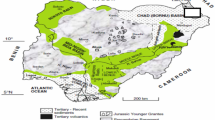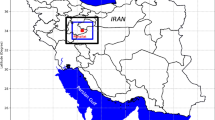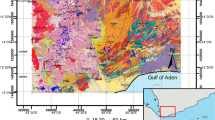Abstract
The Curie point-depth, frequently related to the depth to the bottom of the magnetic source, is widely employed as an estimator of temperature at depth when borehole temperature data are not available. The Curie point-depth is calculated using the spectral analysis of the magnetic data derived from aeromagnetic or satellite surveys. In this paper, MATLAB user-friendly GUI are constructed to calculate the Curie Point Depth using the inversion of aeromagnetic data assuming 2D fractal magnetization and modeling the temperature at depth assuming a 1D steady-state conductive heat transfer model. The program, tested in synthetic and aeromagnetic data, is running under MATLAB 2020a or standalone application with these input parameters: Aeromagnetic data, fractal parameter, Curie temperature, surface temperature, thermal conductivity, surface radiogenic heat production and scaling length of surface radiogenic heat production. The radially averaged amplitude spectrum, scaled spectrum, modeled spectrum, Curie point-depth, and temperature profile at depth are the output parameters of the program. Finally, the program is tested with Texas aeromagnetic data, and the results of the Curie point-depth were compared with borehole data.








Similar content being viewed by others
Change history
31 October 2020
The authors of the above published paper were notified by one of the authors referenced in their paper
References
Adam (2020) getgrd2. MATLAB Central File Exchange. https://de.mathworks.com/matlabcentral/fileexchange/1527-getgrd2. Accessed 20 Aug 2020
Andrés J, Marzán I, Ayarza P, Martí D, Palomeras I, Torné M, Campbell S, Carbonell R (2018) Curie point depth of the Iberian Peninsula and surrounding margins. A thermal and tectonic perspective of its evolution. J Geophys Res Solid Earth 123(3):2049–2068. https://doi.org/10.1002/2017JB014994
Bansal AR, Gabriel G, Dimri VP, Krawczyk CM (2011) Estimation of depth to the bottom of magnetic sources by a modified centroid method for fractal distribution of sources: an application to aeromagnetic data in Germany. Geophysics 76(3):L11–L22. https://doi.org/10.1190/1.3560017
Bhattacharyya BK, Leu LK (1975) Analysis of magnetic anomalies over Yellowstone National Park: mapping of curie point isothermal surface for geothermal reconnaissance. J Geophys Res 80(32):4461–4465. https://doi.org/10.1029/JB080i032p04461
Blakely RJ (1988) Curie temperature isotherm analysis and tectonic implications of aeromagnetic data from Nevada. J Geophys Res Solid Earth 93(B10):11817–11832. https://doi.org/10.1029/JB093iB10p11817
Blakely RJ (1995) Potential theory in gravity and magnetic applications. Cambridge University Press, Cambridge
Bouligand C, Glen JMG, Blakely RJ (2009) Mapping curie temperature depth in the western United States with a fractal model for crustal magnetization. J Geophys Res 114:b11104. https://doi.org/10.1029/2009jb006494
Carrillo-de la Cruz JL, Prol-Ledesma RM, Gómez-Rodríguez D, Rodríguez-Díaz AA (2020) Analysis of the relation between bottom hole temperature data and curie temperature depth to calculate geothermal gradient and heat flow in Coahuila, Mexico. Tectonophysics 780:228397. https://doi.org/10.1016/j.tecto.2020.228397
Connard G, Couch R, Gemperle M (1983) Analysis of aeromagnetic measurements from the Cascade Range and in Central Oregon. Geophysics 48(3):376–390. https://doi.org/10.1190/1.1441476
D’Errico J (2007) Graphical data selection tool. MATLAB Central File Exchange. https://de.mathworks.com/matlabcentral/fileexchange/13857-graphical-data-selection-tool. Accessed 18 May 2019
Fedi M, Quarta T, De Santis A (1997) Improvements to the Spector and Grant method of source depth estimation using the power law decay of magnetic field power spectra. Geophysics 62:1143–1150
Finn CA, Ravat D (2004) Magnetic Depth Estimates and Their Potential for Constraining Crustal Composition and Heat Flow in Antarctica. Eos, Transactions, American Geophysical Union 85 (47), Fall Meeting, Abstract T11A-1236
Fridleifsson IB, Bertani R, Huenges E, Lund JW, Ragnarsson A, Rybach L (2008) The possible role and contribution of geothermal energy to the mitigation of climate change. In: Hohmeyer O, Trittin T (Eds.) IPCC scoping meeting on renewable energy sources. Proceedings, Luebeck, pp 59–80
Gdeisat MA (2011) Flatten a data in 2D. MATLAB Central File Exchange. https://www.mathworks.com/matlabcentral/fileexchange/33192-flatten-a-data-in-2d?s_tid=prof_contriblnk. Accessed 15 Aug 2019
Kumar R, Bansal AR, Ghods A (2020) Estimation of depth to bottom of magnetic sources using spectral methods: Application on Iran's aeromagnetic data. J Geophys Res Solid Earth 125: e2019JB018119. https://doi.org/10.1029/2019JB018119
Li C-F, Shi X, Zhou Z, Li L, Geng J, Chen B (2010) Depths to the magnetic layer bottom in the South China Sea area and their tectonic implications. Geophys J Int 182(3):1229–1247. https://doi.org/10.1111/j.1365-246X.2010.04702.x
Li C-F, Wang J, Lin J, Wang T (2013) Thermal evolution of the North Atlantic lithosphere: new constraints from magnetic anomaly inversion with a fractal magnetization model. Geochem Geophys Geosyst 14(12):5078–5105. https://doi.org/10.1002/2013GC004896
Li C-F, Lu Y, Wang J (2017) A global reference model of curie-point depths based on EMAG2. Sci Rep 7:45129. https://doi.org/10.1038/srep45129
Martos YM, Catalán M, Jordan TA, Golynsky A, Golynsky D, Eagles G, Vaughan DG (2017) Heat flux distribution of Antarctica unveiled. Geophys Res Lett 44(22):11,417–11,426. https://doi.org/10.1002/2017GL075609
Martos YM, Jordan TA, Catalán M, Jordan TM, Bamber JL, Vaughan DG (2018) Geothermal heat flux reveals the Iceland hotspot track underneath Greenland. Geophys Res Lett 45(16):8214–8222. https://doi.org/10.1029/2018GL078289
Martos YM, Catalán M, Galindo-Zaldivar J (2019) Curie depth, heat flux, and thermal subsidence reveal the Pacific mantle outflow through the Scotia Sea. J Geophys Res Solid Earth 124:10,735–10,751. https://doi.org/10.1029/2019JB017677
Maus S, Dimri V (1995) Potential field power spectrum inversion for scaling geology. J Geophys Res Solid Earth 100(B7):12605–12616. https://doi.org/10.1029/95JB00758
Maus S, Gordon D, Fairhead D (1997) Curie-temperature depth estimation using a self-similar magnetization model. Geophys J Int 129(1):163–168. https://doi.org/10.1111/j.1365-246X.1997.tb00945.x
NAMAG (2002) Digital data grids for the magnetic anomaly map of North America. United States Geological Survey Open File Rep. 02–414. https://mrdata.usgs.gov/magnetic/. Accessed 12 Jun 2019
Okubo Y, Matsunaga T (1994) Curie point depth in Northeast Japan and its correlation with regional thermal structure and seismicity. J Geophys Res 99(B11):22363–22371. https://doi.org/10.1029/94JB01336
Okubo Y, Graf RJ, Hansen RO, Ogawa K, Tsu H (1985) Curie point depths of the island of Kyushu and surrounding areas, Japan. Geophysics 50(3):481–494. https://doi.org/10.1190/1.1441926
Pilkington M, Todoeschuck JP (1993) Fractal magnetization of continental crust. Geophys Res Lett 20(7):627–630. https://doi.org/10.1029/92GL03009
Ravat D (2004) Constructing full spectrum potential field anomalies for enhanced geodynamical analysis through integration of surveys from different platforms (INVITED). Eos, Transactions, American Geophysical Union 85 (47), Fall Meeting, Abstract G44A-03
Ravat D, Pignatelli A, Nicolosi I, Champpini M (2007) A study of spectral methods of estimating the depth to the bottom of magnetic sources from near surface magnetic anomaly data. Geophys J Int 169(2):421–434. https://doi.org/10.1111/j.1365-246X.2007.03305.x
Ravat D, Morgan P, Lowry AR (2016) Geotherms from the temperature-depth–constrained solutions of 1-D steady-state heat-flow equation. Geosphere 12(4):1187–1197. https://doi.org/10.1130/GES01235.1
Ridsdill-Smith T (2000) The application of the wavelet transform to the processing of aeromagnetic data. Dissertation, The University of Western Australia
Ross HE, Blakely RJ, Zoback MD (2006) Testing the use of aeromagnetic data for the determination of curie depth in California. Geophysics 71(5):L51–L59. https://doi.org/10.1190/1.2335572
Ruzanski E (2009) Radially averaged power spectrum of 2D real-valued matrix. MATLAB central file exchange. https://de.mathworks.com/matlabcentral/fileexchange/23636-radially-averaged-power-spectrum-of-2d-real-valued-matrix. Accessed 15 Nov 2018
Salem A, Green C, Ravat D, Singh KH, East P, Fairhead JD, Mogre S, Biegert E (2014) Depth to curie temperature across the Central Red Sea from magnetic data using the de-fractal method. Tectonophysics 624–625:75–86. https://doi.org/10.1016/j.tecto.2014.04.027
Shuey RT, Schellinger DK, Tripp AC, Alley LB (1977) Curie determination from aeromagnetic spectra. Geophys J Int 50(1):75–101. https://doi.org/10.1111/j.1365-246X.1977.tb01325.x
SMU Node of National Geothermal Data System (n.d.) SMU Heat Flow Database from BHT Data, http://geothermal.smu.edu/static/DownloadFilesButtonPage.htm. Accessed 10 Jun 2019
Spector A, Grant FS (1970) Statistical models for interpreting aeromagnetic data. Geophysics 35(2):293–302. https://doi.org/10.1190/1.1440092
Tanaka A, Okubo Y, Matsubayashi O (1999) Curie point depth based on spectrum analysis of the magnetic anomaly data in East and Southeast Asia. Tectonophysics 306(3–4):461–470. https://doi.org/10.1016/S0040-1951(99)00072-4
The MathWorks Inc (2020) MATLAB version 9.8.0.1451342 (R2020a Update 5). Natick, Massachusetts.
Wang J, Li C-F (2015) Crustal magmatism and lithospheric geothermal state of western North America and their implications for a magnetic mantle. Tectonophysics 638:112–125. https://doi.org/10.1016/j.tecto.2014.11.002
Wang J, Li C-F (2018) Curie point depths in Northeast China and their geothermal implications for the Songliao Basin. J Asian Earth Sci 163:177–193. https://doi.org/10.1016/j.jseaes.2018.05.026
Acknowledgments
This work was supported by Fondo de Sustentabilidad Energética SENER-CONACyT CeMIE-Geo under Grant-Project P-01: Mapas de Gradiente Geotérmico y Flujo de Calor para la República Mexicana” and to CONACyT for the PhD scholarship to the main author. QGIS software was used in the map creation. We wish to thank to Diana Nuñez and two anonymous reviewers for providing positive comments to improve the manuscript.
Code access
The programs can be downloaded from https://github.com/juanxo90/MAGCPD.
Author information
Authors and Affiliations
Contributions
Juan Luis Carrillo-de la Cruz contributed to stablish the basis of the codes and the application of the methodology. Also, he conceived parts of the code, developed the GIS analysis with the temperature data and wrote the manuscript.
Rosa María Prol-Ledesma contributed to manuscript writing and project scientific development.
Pablo Velázquez-Sánchez contributed to the algorithm development and the GUI interface.
Darío Gómez-Rodríguez contributed to the development of algorithm.
Corresponding author
Additional information
Communicated by: H. Babaie
Publisher’s note
Springer Nature remains neutral with regard to jurisdictional claims in published maps and institutional affiliations.
The original online version of this article was revised: The authors of the above published paper were notified by one of the authors referenced in their paper (Martos et al. 2019), that due to the use of an old version of the paper (now the equation is corrected by the journal), there was an inaccuracies in equation and suggested changing it to a corrected form. The equation number 8 has been corrected.
Rights and permissions
About this article
Cite this article
Carrillo-de la Cruz, J.L., Prol-Ledesma, R.M., Velázquez-Sánchez, P. et al. MAGCPD: a MATLAB-based GUI to calculate the Curie point-depth involving the spectral analysis of aeromagnetic data. Earth Sci Inform 13, 1539–1550 (2020). https://doi.org/10.1007/s12145-020-00525-x
Received:
Accepted:
Published:
Issue Date:
DOI: https://doi.org/10.1007/s12145-020-00525-x




